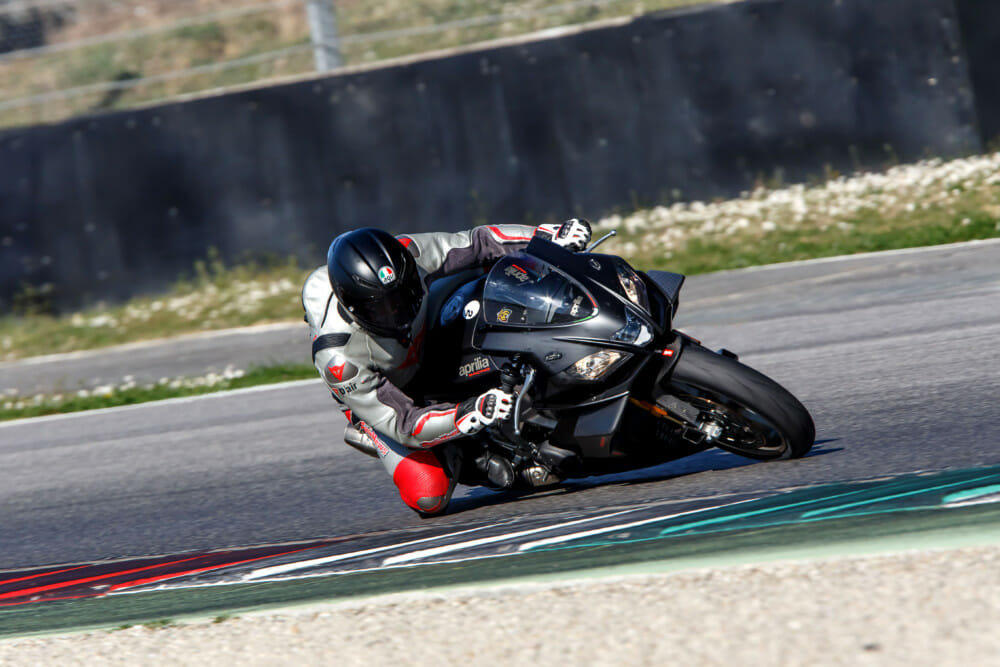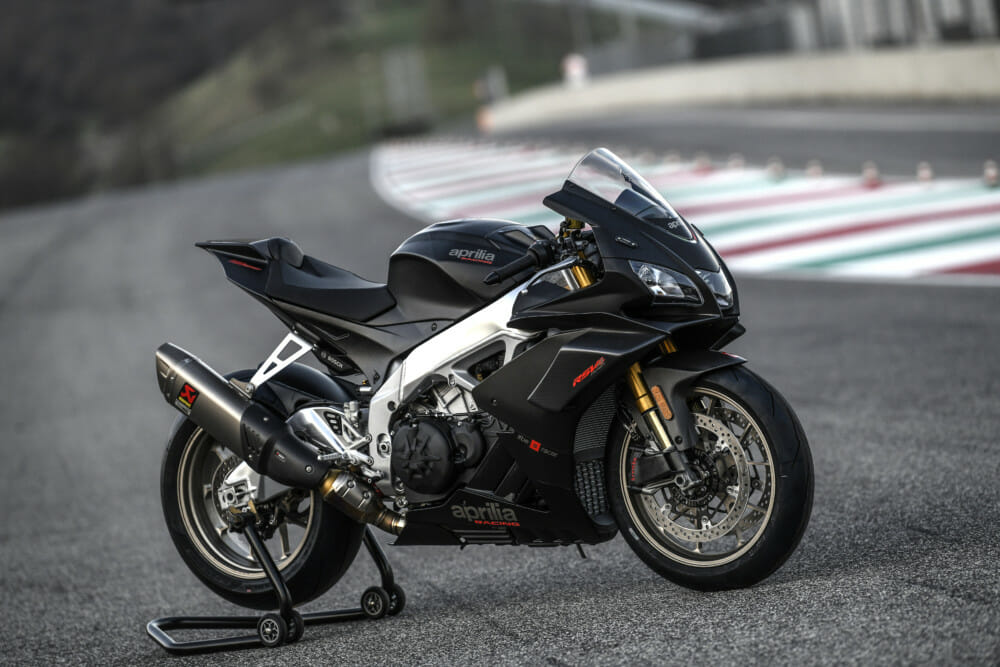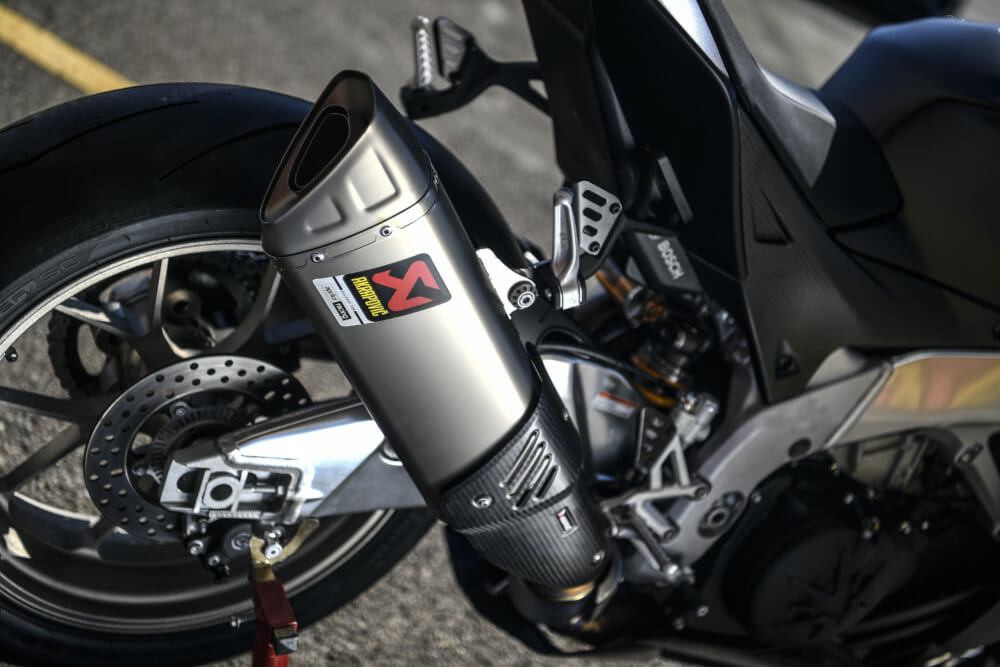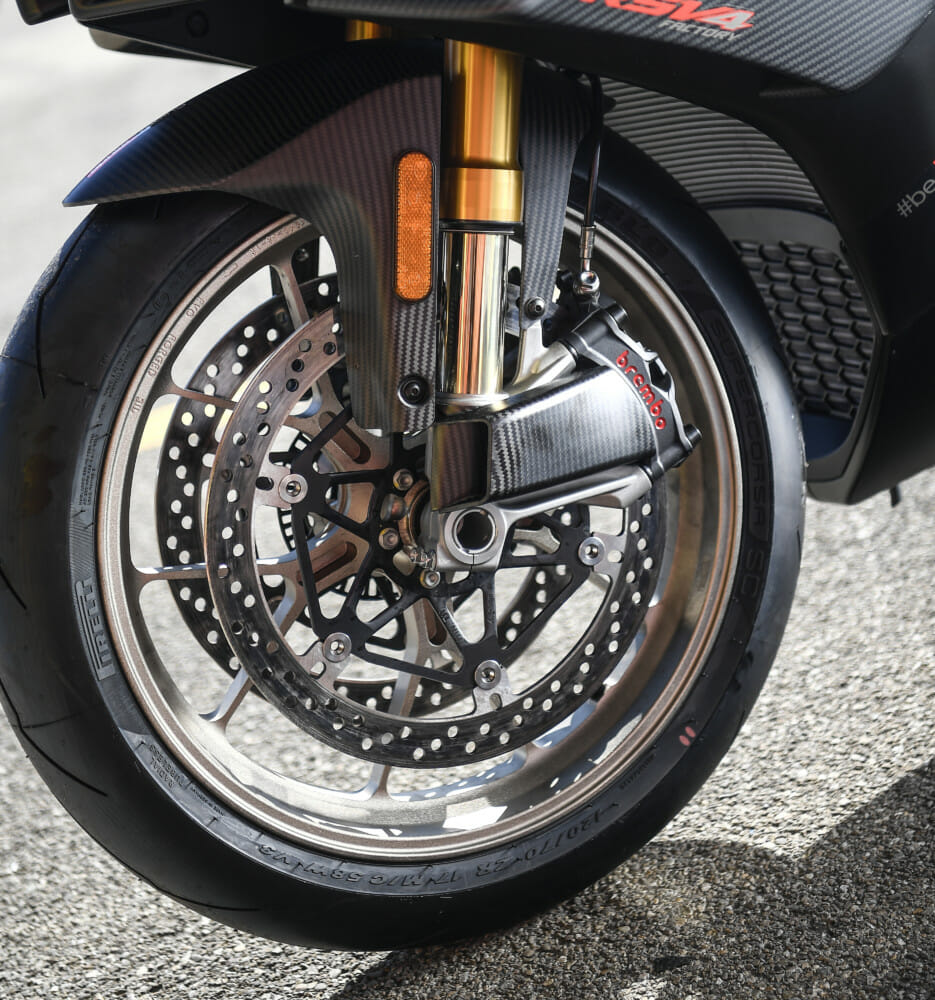The Aprilia RSV4 has been to the gym, lost some weight and gained some serious muscle. We headed to Fantasyland (Mugello) in Italy to stretch it out.

In its 10 years of life, the Aprilia RSV4 has become one of the all-time great superbikes. A near perfect ratio of crushing power via that V4 motor, one of the sweetest chassis ever fitted to a production motorcycle, and with Aprilia being one of the first to fully harness the power of modern rider-aid electronics, means the RSV4 has earned its place on top of the heap. Oh, and it’s won three WorldSBK titles in that time, too. That helps.
Until this year, the RSV4 has always maintained the four-cylinder superbike-racing ceiling of under 1000cc (999.6cc to be exact). Horsepower has improved year on year, to the point where, in 2015, Aprilia claimed 201 hp at the crank from the Noale-built V4.

Photography by Milagro
Click here to read this in the Cycle News Digital Edition Magazine.
Yet for 2019, that’s all changed, as Aprilia has repositioned the RSV4 along the same lines as that other Italian manufacturer down the road in Bologna. The flagship model—the RSV4 Factory—now utilizes an absolutely bonkers 1078cc V4 that pumps out a claimed 217 hp at the crank. This new machine sits alongside the base-model RSV4 RR that still uses an SBK-legal 999cc motor, with a claimed 201 hp at the crank. And you get wings with the Factory. Because, you know, 217 hp…
We are now at a time where 200 horsepower is old hat for the superbike class. What an age we live in.

There are very few places in the world where you can stretch a 1000cc-plus superbike to anywhere approaching its limits. Most tracks around the world will barely allow a sniff at the higher revs in sixth gear, but the Italian MotoGP circuit of Mugello, nestled in the real-life water painting that is the Tuscan countryside about an hour from Florence, is not one of them.
This is the venue where MotoGP machines regularly top 210 mph down the 0.69-mile front straight, so it’s the perfect place to test not just the RSV4’s newfound motor muscle, but also the arguably larger sales pitch of new aero winglets on the side of the fairing.

Even though the motor now pushes north of 210 hp at the crank, the RSV4 1100 is not a ground-up redesign. At its core, the RSV4 is still powered by that 65° V4, which now sports an 81mm bore—the same as allowed in MotoGP—matched to the former motor’s 52.3mm stroke.
Boring out the old motor has given the Noale engineers a healthy increase in power from beginning to end of the rev range. Compared to the 999cc RSV4 RR, at 6000 rpm the 1078cc Factory starts off with a seven horsepower advantage that gets exponentially bigger as the revs rise, culminating in 217 hp at 13,200 rpm compared to the RR’s 201 hp at 13,400 rpm.
But it’s the torque increase that’s extra impressive. At the 6000 rpm, the Factory sits at 68 lb-ft compared to the RR’s 63 lb-ft, culminating at a 90 lb-ft peak at 11,000 rpm to the RR’s 82 lb-ft at the same rpm.

The extra torque right through the rev range has allowed the use of a longer fifth and sixth gear, something seriously helpful down Mugello’s enormous front straight as the 1100 was still pulling like a train at 186 mph when it was time to hit the anchors.
The top speed is one thing, but what’s more interesting is how it gets there. The RSV4 has always had a silky smooth throttle response when you consider the staggering amount of power on tap, and the 1100 is no different. Low speed, low rpm connection from the throttle is superb, allowing you to dial in power progressively and smoothly with nary a dip in forward drive from beginning to end.

The best part is that even though the power is stupendous, it’s not intimidating. Just riding it out of the pits, the RSV4 was smooth and easy to ride, so despite the fact it’ll go 200 mph down the straight, the 1100 will also make a great bike to duck down to the café for a coffee on.
The eagle-eyed will have noticed the new RSV4 Factory motor has the same dimensions as the Tuono 1100, but if you’re thinking about swapping parts, it’s not going to happen. Aside from the cases, the motors are completely different. Airbox, injectors, cams, pistons, crank, and all the assembled parts that go with them—none of them are interchangeable.

It’s difficult not to fall in love with the motor and gearbox on the RSV4. Mated to the Aprilia Quick Shift system as part of the class-leading Aprilia Performance Ride Control (APRC) electronics suite, gear shifts are so fast and direct it’s like like slicing a Katana sword through an eye fillet steak.
Down Mugello’s straight, you throw gear after gear to the motorcycle as the speeds increase north of 190 mph, and at this point, one of the RSV4’s major technological features kicks in. The winglets on the side of the all-carbon fairing will produce 17 lb of downforce at 300 km/h (186 mph). These winglets are the same shape as those mounted on Aleix Espargaro’s RS-GP machine but mounted slightly lower on the fairing as the production bike has the air intake and the headlight assembly to deal with.

The downforce these winglets produce is not enormous, but certainly enough to help keep the front wheel close to the tarmac when you crest the rise at the end of the front straight and keep the chassis stable.
I did not get the opportunity to test the 1100 against the sans-wings 999cc RR, so I cannot make a direct comparison to say they are better or worse when used in anger. What I can say, though, is at an indicated 186 mph on the dash, the 1100 was supremely stable. No headshaking, no funny business—it was like riding a guided missile.
When the time comes to hit the brakes, the wings have another benefit. At those indicated high speeds, the downforce is exerting enough pressure on the fork to slightly compress it so that when you actually hit the Brembo Stylema brakes, there’s not as much weight transfer. The front-end is already loaded, so you dramatically smooth out that transition from top speed to braking. It’s a win-win at high speed. At low speed (i.e., traffic speed), you’ll have to be a seriously, seriously good rider even to tell the wings are there. The downforce at below 100 mph is minimal at best, but hey, at least you’ll look cool!

The motorcycle we rode at Mugello was fitted with the carbon brake-cooling scoop, available as an accessory. Debate raged between journalists at the intro as to whether the benefits of the scoop was noticeable, although Aprilia claims a 20 percent reduction in temperature (20°), lever stroke reduced by 20 percent (5mm), so that brake performance was better maintained than without it.
Again, without a back-to-back comparison of scoop vs. no scoop, it’s hard to say, but the Brembo Stylema package, similar to the one found on the Ducati Panigale V4, has enormous amounts of power and feel at the lever. I certainly didn’t want for more at Mugello, which has some decently hard braking zones from high speed at turn one of San Donato, turn 10 of Scarperia, and the final corner turn 12 of Correntaio.

Correntaio is one of those corners where chassis agility comes to the fore. It’s a wide entry, late apex left-hander, taken in second gear on the 1100. Being able to pull the machine tight and change lines at will has been an RSV4 trademark, and it’s improved once again with the 1100. Running a slightly reduced triple clamp offset and mated to a revised Öhlins NIX fork that’s 5mm longer than before, you can bury the front under braking, load that Pirelli and turn the thing on a dime. It’s a glorious feeling as you give the bars a tug and pull the bike to the apex and pin that throttle, with the weight transferring smoothly to the rear and the Öhlins TTX shock doing its job just right.
The suspension performance is sublime. These are the best conventionally adjusted Öhlins you can buy on a production motorcycle. The suspension is not electronically-adjustable, it’s old school clickers and spanners, but that just means you need to set it up correctly and you’ll have a beautifully suspended machine, rather than letting a computer figure it out for you.

However, computers are a central part of the RSV4’s game in the APRC system. This is one of the finest electronics systems on the market, six different algorithms for traction control, launch control, cruise control, pit lane speed, wheelie control and the quick shift for clutchless gears. Traction control on the Aprilia has always been a great system. It’s adjustable to eight different levels, and truth be told I just stuck it on level three for the four sessions and left it there. It’s more than I ever needed.
The Aprilia Wheelie Control is a likewise brilliant system and adjustable up to three different levels and extremely useful at top speed down the Mugello straight. Coming out of medium-speed corners, the AWC system works separately to the TC and allows you to carry a slight wheelie in levels one and two, working with you to maintain absolute forward drive while still finishing off the turn with the rear wheel. The system is very unobtrusive and gives the rider more and more confidence to maximize drive on acceleration.

Easily the best RSV4 I’ve ever ridden, the 1100 will make you feel like a riding god, even if your lap times tell otherwise. The combination of the motor, chassis, suspension, wings, brakes, and electronics make for a bike that will take some serious beating. The Aprilia RSV4 Factory 1100 is a stunning machine. CN

2019 Aprilia RSV4 1100 Factory Specifications
| MSRP | $24,499 |
| Engine: | Liquid-cooled, Aprilia longitudinal 65° V-4 cylinder, DOHC, 4-valves-per cylinder, 4-stroke |
| Displacement: | 1078cc |
| Bore x stroke: | 81 x 52.3 mm |
| Compression ratio: | 13.6:1 |
| Fuel system: | 4 Marelli 48mm throttle bodies with 8 injectors, Ride-By-Wire engine management. |
| Power (claimed): | 217 hp at 13,200 rpm |
| Torque (claimed): | 82 lb-ft at 13,400 rpm |
| Exhaust: | 4-2-1, two lambda probes, lateral single Akrapovic silencer with ECU-controlled bypass valve and integrated trivalent catalytic converter (Euro 4). |
| Clutch: | Wet multi-plate |
| Transmission: | 6 speed with Aprilia Quick Shift (AQS) |
| Electronics: | APRC System (Aprilia Performance Ride Control), includes Traction Control (ATC), Wheelie Control (AWC), Launch Control (ALC), cruise control (ACC) and speed limiter (APT) |
| Chassis: | Aluminum twin-spar, adjustable headstock and rake, engine height and swingarm pivot height |
| Front suspension: | Fully adjustable 43mm Öhlins NIX fork |
| Rear suspension: | Fully adjustable Öhlins TTX36 unit, aluminum double-sided swingarm |
| Front wheel travel: | 4.9 in. |
| Rear wheel travel: | 4.7 in. |
| Front brake: | Dual Brembo Stylema radially mounted calipers, dual 330mm floating discs, Bosch Cornering ABS |
| Rear brake: | 220mm disc, 2-piston caliper, Bosch Cornering ABS |
| Front tire: | Pirelli Diablo Supercorsa SP 120/70 ZR17; 3.50 x 17 in. rim |
| Rear tire: | Pirelli Diablo Supercorsa SP 200/55 ZR17; 6.00 x 17 in. rim |
| Wheelbase: | 56.6 in. |
| Seat height: | 33.5 in. |
| Fuel capacity: | 4.8 gal |
| Weight (curb, claimed): | 438 lbs. |
Click here to read this in the Cycle News Digital Edition Magazine.
Click here for more Aprilia motorcycle reviews and news.
